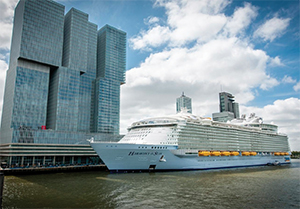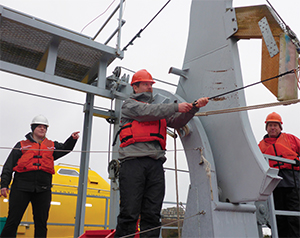The number of injuries and fatalities during lifeboat drills in recent years point to training and equipment shortcomings that have raised concerns across the maritime industry, undermining the confidence of seafarers whose lives and careers hang in the balance.
One of the most serious incidents occurred dockside in the Canary Islands in February 2013. Eight crew on the cruise ship Thomson Majesty were aboard a lifeboat as it was being lowered during a drill. Partway down, the forward wire parted and the aft hook then failed. The lifeboat fell approximately 65 feet to the water and overturned. Five crewmembers died.
Two other fatal drills occurred in 2016, in Bermuda on Norwegian Breakaway and in France aboard Harmony of the Seas. These incidents also involved vessels in the cruise industry, which has seen the majority of lifeboat drill casualties, but they have happened on cargo vessels and drill rigs as well.
Capt. Ed Nanartowich, with 34 years of experience at sea and currently the president of Mid-Atlantic Maritime Academy in Norfolk, Va., believes that one of the faults is inadequate inspection of the equipment. In the case of life-saving appliances (LSAs) on a gravity davit, the equipment is the lifeboat and all the gear involved in launch and recovery. He listed some of the items that need to be carefully checked and maintained — oil levels, slushed wire falls, greased sheaves, frapping lines, tricing pendants — and added, “They all need attention at their appropriate periodicity.”
As it turns out, the final investigation report of the Thomson Majesty tragedy by Transport Malta concluded that the wire rope had been inspected, as required, at the appropriate intervals by the vessel safety officer and an approved contractor. However, it also found that the wire rope was a lower grade than required and had inferior strength. The accident was the result of “a parted wire rope fall that was caused by severe internal corrosion at the break point.” Wire rope in LSAs is subjected to harsh conditions and needs ongoing inspection and analysis.
 |
|
One crewmember died and four others were seriously injured after a lifeboat detached from Harmony of the Seas and fell to the water during a drill in Marseilles, France, in September 2016. The ship is shown here in the Port of Rotterdam. |
|
Courtesy Wartsila |
Nanartowich said fault sometimes lies with the infrequency of drills, stating that problems can occur if davit-launched lifeboat drills “are not exercised religiously by people who are competent at lowering the boats and then recovering them.” The more frequently crews drill, the greater the mental and muscle memory they acquire, which gives them confidence that they know proper and safe procedures.
The core mission of the cruise industry is customer service and happy guests, so crews might feel that their main job is to provide a good vacation at sea for passengers. But this could have ramifications for emergency drill safety. Eric Dawicki, president and CEO of Northeast Maritime Institute in Fairhaven, Mass., said crews must be prepared to be effective.
“Drills must never be rushed, and crewmembers must never feel rushed,” he said. “Drills must be thought out, pragmatic and realistic given the equipment available. And there should be time for crew to be briefed and debriefed.”
A 2016 report by the Seafarers International Research Centre found that tight vessel schedules often do not allow sufficient time for drills, resulting in inadequate training exercises and some drills being recorded but not completed. The report, based on in-depth interviews as well as questionnaires involving 2,500 mariners, also found that some seafarers step back from participation in drills “due to fear of the equipment involved.”
Although some drills involve both crew and passengers, Dawicki said crews need to have segregated drills “intended to provide a high level of training beyond the initial certification training.” He emphasized the importance of these drills occurring in an environment where crewmembers feel they have time to talk about how to properly use the equipment. If necessary, an arrangement for refresher training protocols should be in place as well.
Capt. Thomas E. Bliss, director at Northwest Maritime Academy in Gig Harbor, Wash., said he has not heard academy trainees report that a drill made them fearful or that their lives were in danger, a mindset enhanced by never rushing a training exercise. “Accidents happen (when) drills for an individual crewmember are too few and far between, and when there’s unfamiliarity with the equipment,” he said.
LSA equipment at this point should involve the next generation of release and retrieval hooks, Bliss said, with trainers understanding the errors most frequently occurring during drills. “You use it or lose it,” he said in regard to training. “If you don’t use a checklist, you start forgetting steps in the process of deploying or recovering a lifeboat.”
Drills that are rushed or incomplete point to a leadership problem. Senior and junior officers have a responsibility to ensure that enough time is devoted to what Dawicki calls a “safety culture.”
This culture can be compromised by communication difficulties on ships with multinational crews. This is particularly true in the cruise industry, which has ships with much larger crews than other commercial sectors. When Royal Caribbean introduced Harmony of the Seas in 2016, it had a crew of 2,100 representing 77 nationalities. Even if all of those crewmembers spoke reasonable English, the potential for misunderstanding — between crewmembers as well as between crewmembers and officers —was high.
“Communication should be key to any operation, including drills, but can be a weak link when a seafarer might smile, nod and say ‘yessir’ even though they don’t quite get what you said,” Nanartowich said.
 |
|
Deck supervisor Kelsye Carlson, left, directs Jesse Baker to release the tricing pendant on a gravity davit lifeboat during a proficiency exercise at Compass Courses Maritime Training in Edmonds, Wash. At right is trainee John Carl. |
|
Courtesy Compass Courses |
Dawicki, a delegate at the International Maritime Organization since 1996, expressed concern about some flag states watering down safety-skill re-certification under the Standards of Training, Certification and Watchkeeping for Seafarers (STCW).
“The purpose of STCW is to credential mariners for performance in the field,” he said. “In the original plan, there was to be a standard refresher program — repeating the entire course — once every five years. Mariners needed to demonstrate at those intervals that they were still capable of performing all the safety skills.”
The problem, Dawicki said, is that some registries may be accepting recertification programs whittled down to 16 or even eight hours of that original full-week course.
The loss of 123 crew from the offshore oil rig Alexander L. Kielland in the North Sea in 1980 led to improvements in the LSA hook mechanisms on oil rigs and then on merchant ships. As tragedy prompted remediation in that incident, there is hope among some in the industry that the recent spate of incidents will lead to improvements in lifeboat drills and systems. Others are more skeptical, including Mark Dickinson, general secretary of Nautilus International, a London-based maritime trade union and professional organization.
“It is appalling that the industry seems incapable (of) solving this problem,” Dickinson said in September after the Harmony of the Seas incident. “It is high time that we had some radical thinking about the whole concept of lifeboats and examine the potential of alternative evacuation systems.”

